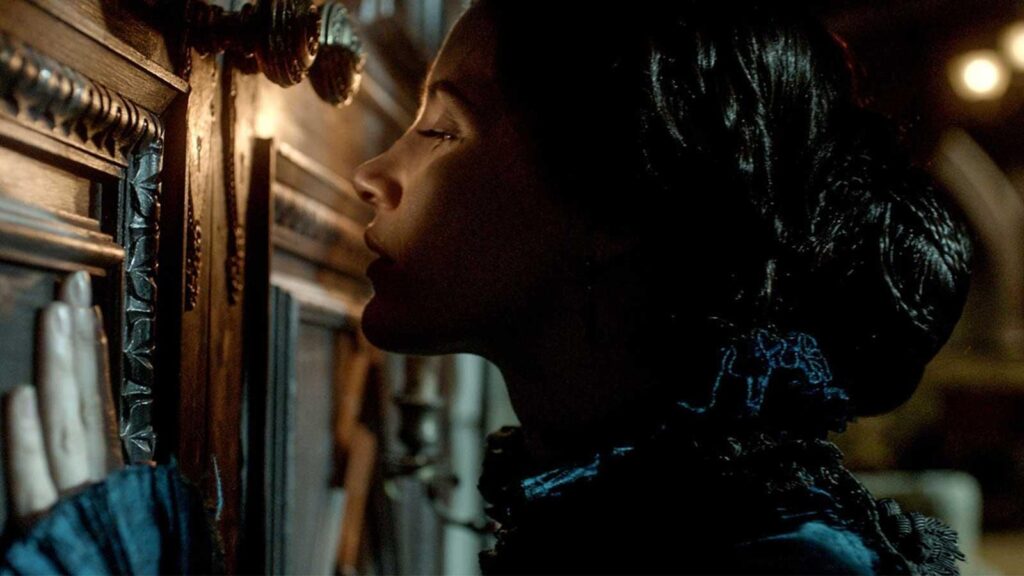Spooky and twisted, “Crimson peak” is an epitome of gothic aesthetics and narrative. You can trust me on this, my dear reader, because I’m an immense fan of the genre and I can assure you that my perceptiveness of its quality is keen and trustworthy. That being said loud and clear, I can proceed with my exposé.
When I observe the aesthetic dimension of this film I almost experience what Edmund Burke would call ‘the beautiful and the sublime.’ This concept refers to the pleasure produced by our contemplation of an artwork, which in theory is called an ‘aesthetic pleasure’. Edmund Burke, however, treats the romantic vision of art and the ways that beautiful is connected to the sublime. As it’s widely known—it’s in Romanticism and Sturm und Drang—that the gothic narrative and aesthetics are born and cultivated. We do witness it’s revival in Modernism at the beginning of the 20th Century, with sporadic examples of the genre made later on until our days. The focal point of “Crimson peak” is not its plot nor it’s story, but rather the beauty. I think I’ve even read somewhere a negative critique of the film in which the reviewer called the movie disappointing because of its loose plot, which just tells about his or her incompetence and I’m going to demonstrate just how much this is the case.
First of all, the gothic narrative is simple, the characters are plain and one-dimensional, while the accent is being put on the anticipation, suspense, mystery, unknown, enigmatic, unsaid, strange, supernatural even. Supernatural forces are a light motive of these novels and films, and premonitions are key elements which create the tension that impregnates the entire narrative stream.
Going back to the characters, we do notice the polarisations: they’re either good or bad, they rarely experience complex emotions, and when they do it’s mostly confusion or doubt. The introspection is usually non-existent because there’s no psychological development or substantial change in them. The narrative is simple: we have a set of plain characters that are not even characters in the strict sense of the word because they serve as a function. There’s the protagonist, usually an embodiment of universally positive traits: in this case it’s Edith (Mia Wasikowska), a naive, young, innocent, and loving woman, oblivious to all the evil that’s going to befall her.

There’s the antagonist, which is Lucille (Jessica Chastain), the possessive, incestuous, demonic and evil woman that poisons the angelical, good-hearted heroine. On the other hand, there’s the ambivalent hero, Thomas (Tom Hiddleston), Lucilles’s brother and lover, and Edith’s husband. He falls in love with Edith, even though at first he only acts as the executor of Lucille’s plans to get the inheritance of his brides. We also have supernatural forces, which are there as premonitors: Edith’s mother’s ghost that appears twice in the film to warn her about Crimson Peak, and Lucilles’ and Thomas’ mother, which is there as an evil force and as I saw it, only to create a scary, phantomic mood. The traditional plot is therefore almost absent, which, to non-experts may look like a shortcoming of some sort.
Almost all action happens at night, as Edith wakes up because of either physical pain (she’s being poisoned) or just as a result of a nightmare. Then, a set of unsettling events takes place: unexpected sounds and appearances make our heroine become more and more dreadful, vigilant, and suspicious of the situation. The dominant setting, just as in a typical gothic novel, is an old haunted mansion, Allerdale Hall, with its rotting and squeaky, dark, wooden interior, and antique and dusty furniture. Colours play a central role in creating this type of atmosphere: red and yellow being the most dominant, apart from black and dark brown, which forms a striking contrast.
The major theme is almost certainly a love story, and the pain experienced by Edith after she finds out about Thomas’ betrayal, and it’s what makes this movie deeply touching. It’s not the culmination and Lucille’s murder attempts that are indeed quite aesthetically pleasing, but rather the circumstances. Firstly, as Edith catches the siblings engaged in a sexual act, at the same time the viewers come to the final realization that something odd and perturbing is beneath this apparently simple plot. Shortly afterwards, the plot’s almost immediately continued with Lucille trying to kill both of them, which is not even remotely impactant as the previous event that sets the bitter tone to the film.